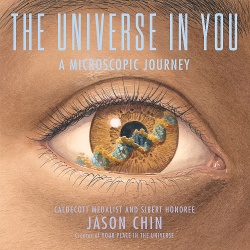Jason Chin won the Caldecott Medal last year for Watercress (written by Andrea Wang). He's back with the stunning The Universe in You, which he both wrote and illustrated. Will the Caldecott gods smile twice in a row?
[Many Calling Caldecott posts this season will begin with the Horn Book Magazine review of the featured book, followed by the post's author's critique.]

 The Universe in You: A Microscopic Journey
The Universe in You: A Microscopic Journey
by Jason Chin; illus. by the author
Primary, Intermediate Porter/Holiday 40 pp.
12/22 9780823450701 $18.99
e-book ed. 9780823454310 $11.99
Chin follows his acclaimed Your Place in the Universe (rev. 11/20) with an equally stellar exploration of the tiniest components of matter conceptualized by science. The book opens with a brown-skinned child who uses a wheelchair visiting a Southwestern desert. The United States’ smallest bird, butterfly, and bee, in turn, alight on her finger, in close-ups that ultimately zoom in to a hair on that finger and put in motion a journey inward to the “building blocks” of biology and physical science. The expedition moves from skin cells to molecules, then to atoms, protons, and elementary particles. Each page-turn, ending in suspenseful sentence breaks (“But the cell nucleus is gigantic compared to… / …everything else inside the cell”), takes readers to the next step inward. Chin’s stunning watercolor and gouache illustrations, colorfully detailed and scientifically accurate, employ perspective to draw readers into observations of life and matter within the smallest possible spaces. The back matter adds details to the text’s brief definitions and delineates where the art departs from settled science (in color and spatial relationships). The main text ends philosophically: we are all made of “the same stuff as everything else in the universe,” and yet each of us is a “singular person, who can think and feel and discover… / …the universe within.” DANIELLE J. FORD
From the January/February 2023 issue of The Horn Book Magazine.
It was a good year for nonficiton picture books, and Calling Caldecott has covered quite a number of them this season. Jason Chin's The Universe in You is surely among the most ambitious of the bunch. A picture book that addresses the question: What Is Life? You don't see that every day! Chin delievers a scientifically rigorous exploration of the tiniest components of matter, down to (the practically unimaginable) elementary particles. The illustrations of cells, molecules, atoms, etc., are not only scientifically accurate and colorfully detailed; they are also stunningly composed, full of movement and, well, life.
It's not just the sheer mastery of the scientific illustration that warrants Caldecott consideration, though. Equally important is A) the book's trajectory, its shape; and B) its heart, its humanity. It's hard, though, to talk about one without the other because they're so intertwined.
Let's start with the visual framing device (which is so much more than a device) of the beautiful brown-eyed girl visiting a desert wildlife center. Look at that arresting cover, which draws our attention immediately to the girl's eye. Because of that eye we know right away that this will be both a scientific story (with the DNA strand crossing her pupil) and a human story (oh my the WARMTH conveyed in that glimpse of her face). Inside the book, we are expertly led, spread by spread, to focus on smaller and smaller things — but always via our brown-eyed girl. Chin shows us a tiny hummingbird, then a tiny bee that has landed on her finger, then comes closer in to show a hair on that finger, then closer still to depict skin cells, and so on. Once Chin has reached the very furthest level of our understanding of the smallest components of matter, he then starts the return journey, where we see the same hummingbird (from the beginning of the book) as though looking at it through the girl's eye. I find this spread so brilliant — it brings us back to the surface and let's Chin segue to shifting perspective so that we are once again looking at the girl from the outside. "A unique human being ... a singular person, who can think and feel and discover ... the universe within."
Jason Chin won the Caldecott Medal last year for Watercress (written by Andrea Wang). Of course, that shouldn't matter a whit to the Real Committee, who are supposed to look only at the books of 2022 in comparison with one another. And of course there's precedence for back-to-back Caldecott winners: Leo and Diane Dillon, who won in 1976 for Why Mosquitoes Buzz in People's Ears and in 1977 for Ashanti to Zulu. Will we be hearing Jason Chin's name next Monday at the Youth Media Awards ceremony when the winners are announced? He would definitely deserve it.
ALREADY A SUBSCRIBER? LOG IN
We are currently offering this content for free. Sign up now to activate your personal profile, where you can save articles for future viewing.








Add Comment :-
Be the first reader to comment.
Comment Policy:
Comment should not be empty !!!